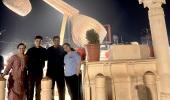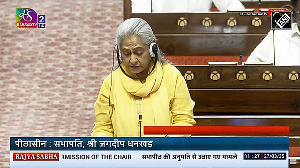On February 18, 1911, French pilot Henri Pequet carried 6,500 mails in the world's first official airmail flight over Allahabad, coinciding with the Kumbh Mela.

On February 18, 1911, French pilot Henri Pequet took off in his biplane from an exhibition ground, carrying about 6,500 mails and postcards and soared into the evening sky of Allahabad, as it was known then, and into the pages of aviation and postal history.
This was the world's first official airmail flown by an aeroplane and the pioneering milestone coincided with the Kumbh Mela that took place in Prayagraj 114 years ago, according to philately experts.
The aircraft that became part of this historic flight, flew a distance of about five miles, crossed Yamuna and landed at a site near the Naini Jail in a span of nearly 13 minutes.
Among the recipients of the mails was a young Jawaharlal Nehru (later India's first prime minister) who was in England at the time, and George V -- the then king of the British empire.
Mails were also addressed to many royals and commoners.
Each of the mails carried a special postmark depicting an airplane, mountains and bore the text -- 'First Aerial Post, 1911, U. P. Exhibition Allahabad'.
Special commemorative photo postcards bearing images of the two-seater Humber biplane and the pilot and signed by Pequet were also part of the consignment, a prized collector's item among philatelists across the world.
Unlike the vast multitudes of people gathered on the banks of Triveni Sangam -- the confluence of rivers Ganga, Yamuna and the mythical Saraswati -- in 1911 in Allahabad, now renamed Prayagraj, Pequet's arrival at Naini was a rather quiet affair.
According to archival records, the pilot who had to carry a compass instrument tied to his lap and the mail bag accommodated just near the edge of his seat, handed over the sack to a postal official present at the landing site.
From there, the letters and postcards were transmitted to their respective destinations by surface mail, as in by road or by ship or by train, as was the traditional postal practice then.
Prayagraj resident and young history scholar Akshat Lal, who has paid multiple visits to the ongoing Kumbh Mela of 2025, shares an exciting link of his family with the carriage of the world's first official airmail.
"I have a soft copy of a postcard flown on that aeroplane and it was addressed to my great grandfather 'Asharfi Lall, Esq.' and carried the 'First Aerial Post, 1911, U. P. Exhibition Allahabad' postmark in black, and the date mark '18 FE. 11'," Lal told PTI in Prayagraj.
United Provinces Exhibition was held on a ground near the Allahabad Fort facing the Sangam, from December 1910 till the end of February 1911.
Aeroplanes were showcased at the exhibition through demonstration flights. The province was later renamed as Uttar Pradesh.
An avid collector himself, Lal also has a physical copy of an envelope addressed to a person in Allahabad and carrying the commemorative postmark in magenta, over a rare half-anna postage stamp bearing the silhouetted image of King Edward VII whose son George V travelled to India to attend his coronation durbar in Delhi on December 12, 1911.
Patna-based philatelist and author Pradip Jain, or 'aerophilatelist' as he also calls himself, said this historic occasion that accords India a place in iconic aviation and postal history coincided with the Kumbh, making it even more special for India and its people.
"Many of the mails were also sent to Bhagalpur and Champaran in Bihar region and I have a rare collection of a few of them, besides the envelope carrying the name of Jawaharlal Nehru addressed to him by his father," Jain told PTI.
Jain has written about this 1911 flight in his book Indian Airmails: Development and Operations (1911-1942), published in 2002, and said he also possessed a few 'signed Pequet postcards'.
A special stamp was issued in 1961 to mark the golden jubilee of that historic first flight.
"On the centenary of this event in 2011, the Government of India had issued a commemorative postal miniature sheet. And, on February 18, this year I also delivered a talk on this subject in an online international seminar. In a fitting tribute to the 1911 flight, the seminar took place while the Kumbh was underway," Jain said.
The 45-day religious congregation began this year on January 13 and will culminate on February 26. Over 600 million people have taken a holy dip in the Triveni Sangam since it started, according to data shared by the Uttar Pradesh government.
The magenta colour postmark for the 1911 event was made with a special dye manufactured in Aligarh. It is said that this dye was destroyed later to make the letters and postcards carried by Pequet, a rarity in future, and indeed these are today even after 114 years, experts said.
Jain, in his early 70s, said while the magenta postmark or cachet was a rarity, black ink was used 'for the privileged few, while some had it both magenta and black'.
The ministry of communication recently also acknowledged the 1911 event and its coincidence with Kumbh that year as perhaps the 'sangam' of postal history and spiritual heritage of India.
'These letters are living documents of their time. Many of these letters have transformed into pages of literature. While postal services now reach across the world via airplanes, their history is intrinsically linked to the Kumbh and Prayagraj,' it said in a statement.
'These letters defined the concept of globalisation in an era when travelling abroad was a distant dream. The airmail service not only gave wings to the letters but also provided flight to people's dreams,' the ministry said.











 © 2025
© 2025